Management Accounting: Techniques, Budgeting, Pricing, Costing, and Strategic Position
VerifiedAdded on 2023/01/10
|12
|2644
|24
AI Summary
This report discusses the usefulness of management accounting in evaluating business aspects and making crucial decisions. It covers microeconomic techniques, product costing, income statement using marginal and absorption costing, budgeting, pricing, costing, and strategic position. The report also compares different management accounting systems used by organizations to resolve financial problems.
Contribute Materials
Your contribution can guide someone’s learning journey. Share your
documents today.
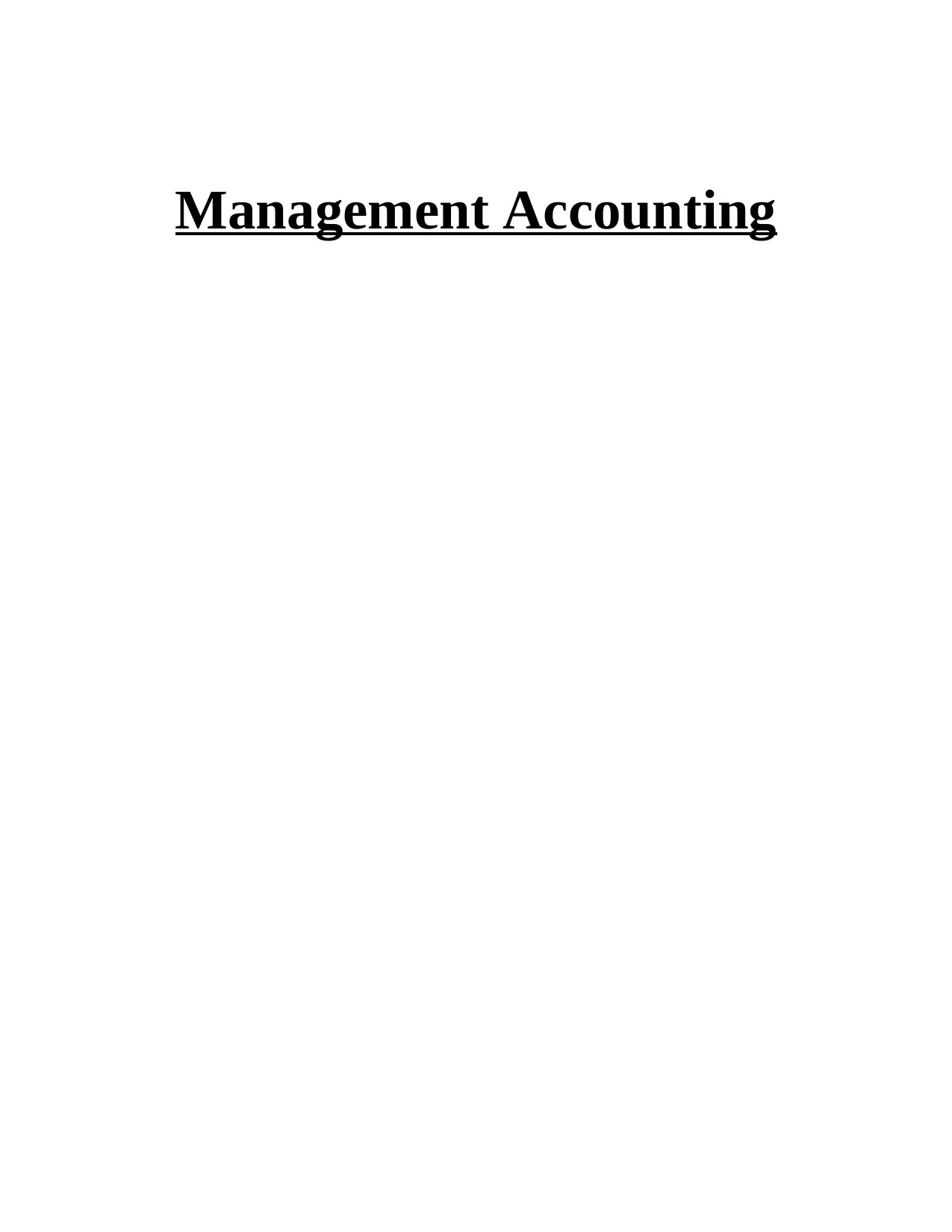
Management Accounting
Secure Best Marks with AI Grader
Need help grading? Try our AI Grader for instant feedback on your assignments.
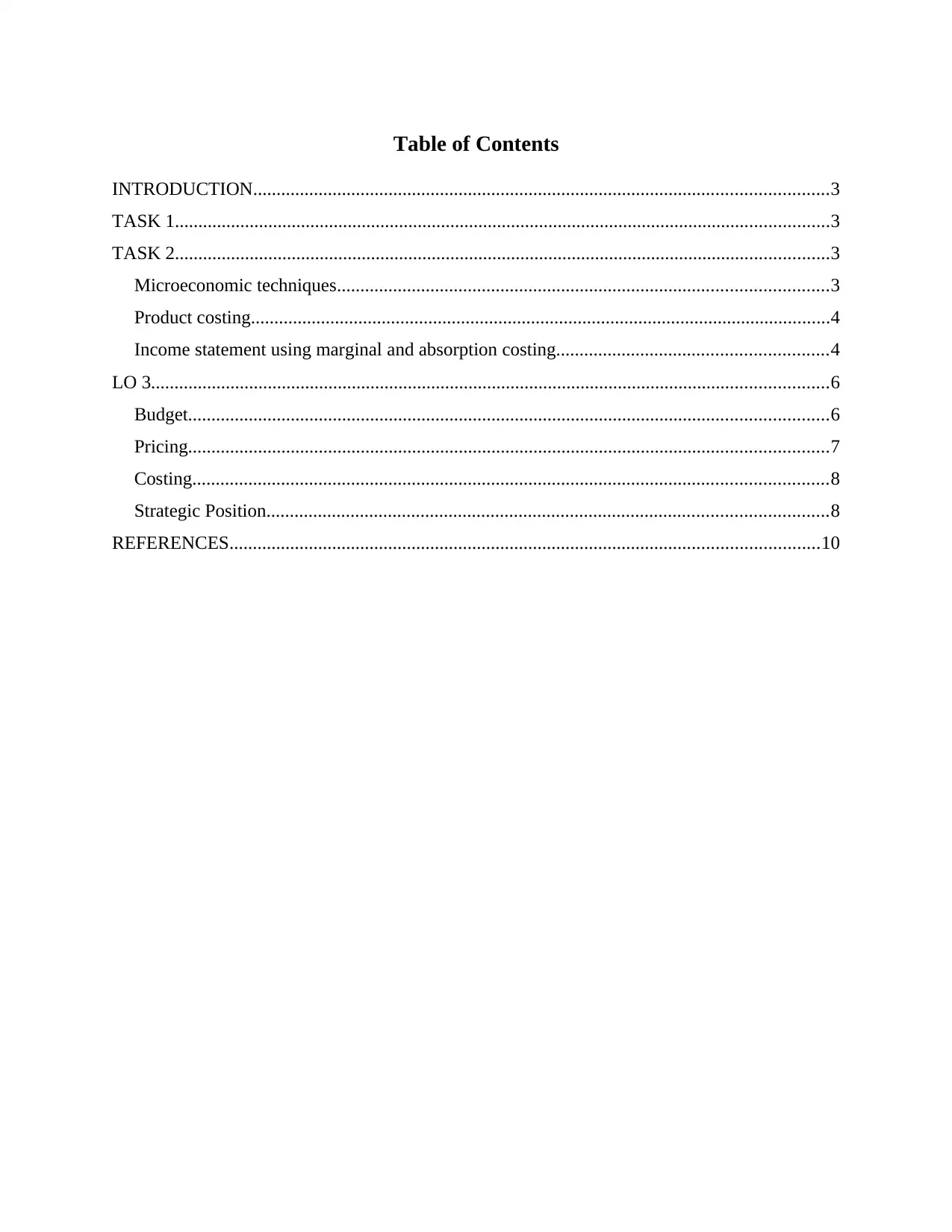
Table of Contents
INTRODUCTION...........................................................................................................................3
TASK 1............................................................................................................................................3
TASK 2............................................................................................................................................3
Microeconomic techniques.........................................................................................................3
Product costing............................................................................................................................4
Income statement using marginal and absorption costing..........................................................4
LO 3.................................................................................................................................................6
Budget.........................................................................................................................................6
Pricing.........................................................................................................................................7
Costing........................................................................................................................................8
Strategic Position........................................................................................................................8
REFERENCES..............................................................................................................................10
INTRODUCTION...........................................................................................................................3
TASK 1............................................................................................................................................3
TASK 2............................................................................................................................................3
Microeconomic techniques.........................................................................................................3
Product costing............................................................................................................................4
Income statement using marginal and absorption costing..........................................................4
LO 3.................................................................................................................................................6
Budget.........................................................................................................................................6
Pricing.........................................................................................................................................7
Costing........................................................................................................................................8
Strategic Position........................................................................................................................8
REFERENCES..............................................................................................................................10
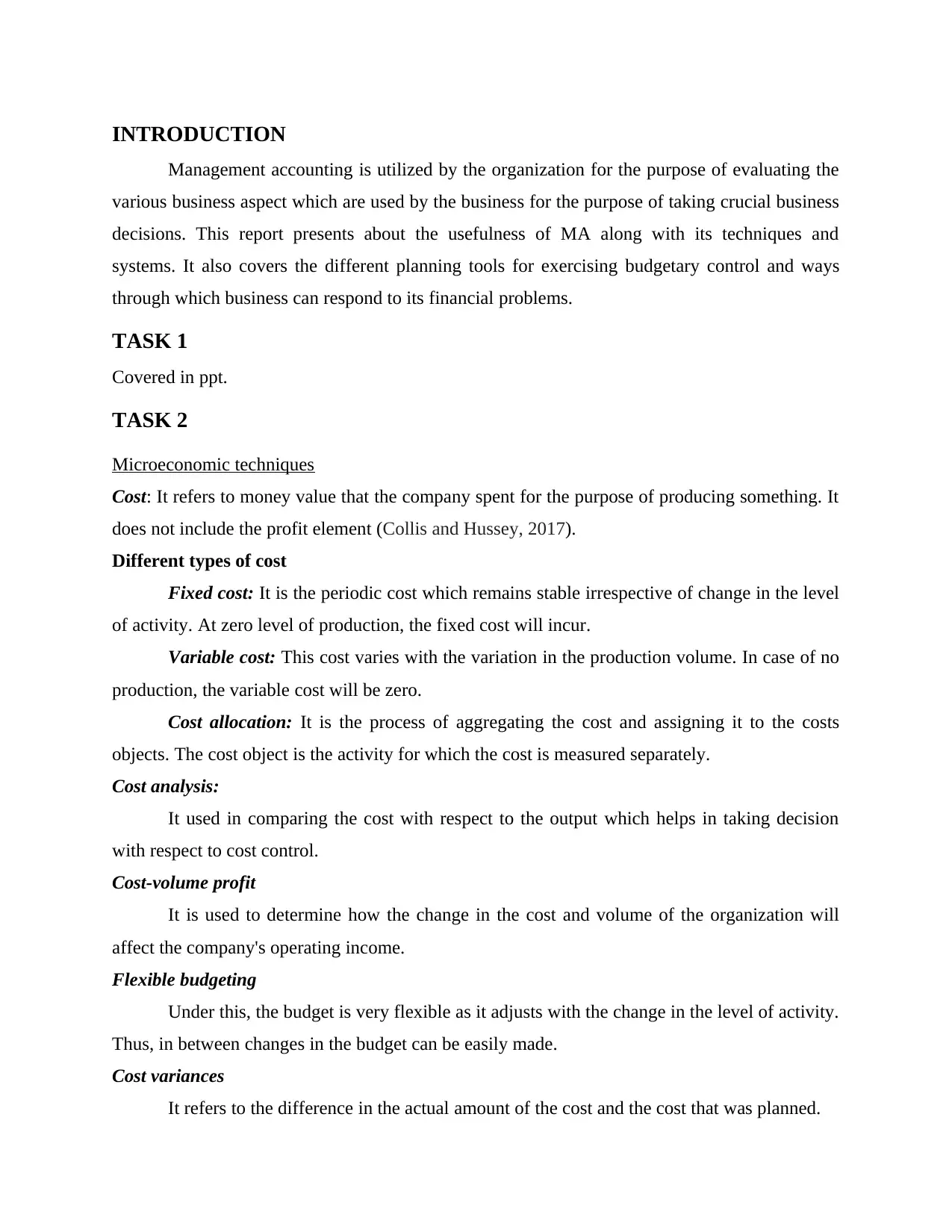
INTRODUCTION
Management accounting is utilized by the organization for the purpose of evaluating the
various business aspect which are used by the business for the purpose of taking crucial business
decisions. This report presents about the usefulness of MA along with its techniques and
systems. It also covers the different planning tools for exercising budgetary control and ways
through which business can respond to its financial problems.
TASK 1
Covered in ppt.
TASK 2
Microeconomic techniques
Cost: It refers to money value that the company spent for the purpose of producing something. It
does not include the profit element (Collis and Hussey, 2017).
Different types of cost
Fixed cost: It is the periodic cost which remains stable irrespective of change in the level
of activity. At zero level of production, the fixed cost will incur.
Variable cost: This cost varies with the variation in the production volume. In case of no
production, the variable cost will be zero.
Cost allocation: It is the process of aggregating the cost and assigning it to the costs
objects. The cost object is the activity for which the cost is measured separately.
Cost analysis:
It used in comparing the cost with respect to the output which helps in taking decision
with respect to cost control.
Cost-volume profit
It is used to determine how the change in the cost and volume of the organization will
affect the company's operating income.
Flexible budgeting
Under this, the budget is very flexible as it adjusts with the change in the level of activity.
Thus, in between changes in the budget can be easily made.
Cost variances
It refers to the difference in the actual amount of the cost and the cost that was planned.
Management accounting is utilized by the organization for the purpose of evaluating the
various business aspect which are used by the business for the purpose of taking crucial business
decisions. This report presents about the usefulness of MA along with its techniques and
systems. It also covers the different planning tools for exercising budgetary control and ways
through which business can respond to its financial problems.
TASK 1
Covered in ppt.
TASK 2
Microeconomic techniques
Cost: It refers to money value that the company spent for the purpose of producing something. It
does not include the profit element (Collis and Hussey, 2017).
Different types of cost
Fixed cost: It is the periodic cost which remains stable irrespective of change in the level
of activity. At zero level of production, the fixed cost will incur.
Variable cost: This cost varies with the variation in the production volume. In case of no
production, the variable cost will be zero.
Cost allocation: It is the process of aggregating the cost and assigning it to the costs
objects. The cost object is the activity for which the cost is measured separately.
Cost analysis:
It used in comparing the cost with respect to the output which helps in taking decision
with respect to cost control.
Cost-volume profit
It is used to determine how the change in the cost and volume of the organization will
affect the company's operating income.
Flexible budgeting
Under this, the budget is very flexible as it adjusts with the change in the level of activity.
Thus, in between changes in the budget can be easily made.
Cost variances
It refers to the difference in the actual amount of the cost and the cost that was planned.
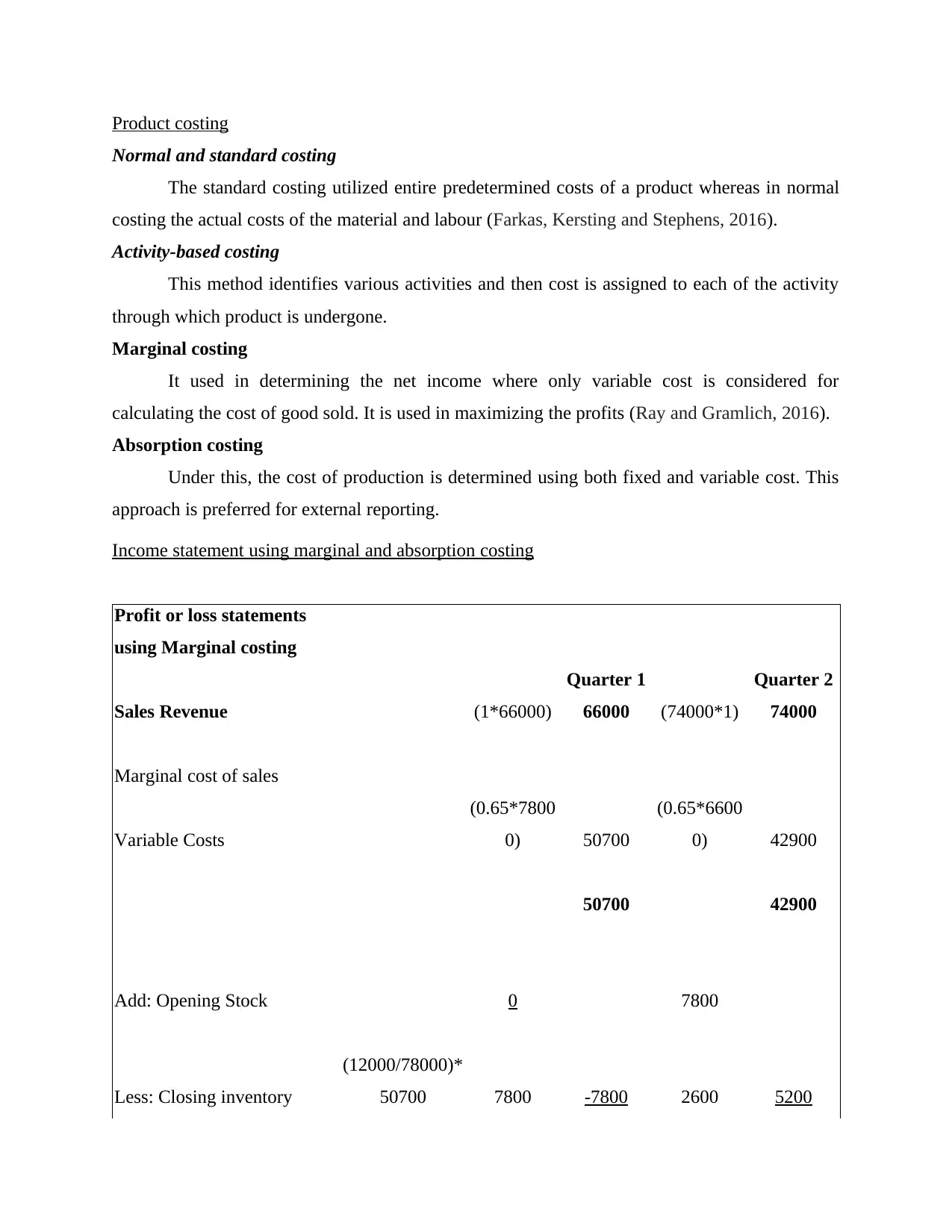
Product costing
Normal and standard costing
The standard costing utilized entire predetermined costs of a product whereas in normal
costing the actual costs of the material and labour (Farkas, Kersting and Stephens, 2016).
Activity-based costing
This method identifies various activities and then cost is assigned to each of the activity
through which product is undergone.
Marginal costing
It used in determining the net income where only variable cost is considered for
calculating the cost of good sold. It is used in maximizing the profits (Ray and Gramlich, 2016).
Absorption costing
Under this, the cost of production is determined using both fixed and variable cost. This
approach is preferred for external reporting.
Income statement using marginal and absorption costing
Profit or loss statements
using Marginal costing
Quarter 1 Quarter 2
Sales Revenue (1*66000) 66000 (74000*1) 74000
Marginal cost of sales
Variable Costs
(0.65*7800
0) 50700
(0.65*6600
0) 42900
50700 42900
Add: Opening Stock 0 7800
Less: Closing inventory
(12000/78000)*
50700 7800 -7800 2600 5200
Normal and standard costing
The standard costing utilized entire predetermined costs of a product whereas in normal
costing the actual costs of the material and labour (Farkas, Kersting and Stephens, 2016).
Activity-based costing
This method identifies various activities and then cost is assigned to each of the activity
through which product is undergone.
Marginal costing
It used in determining the net income where only variable cost is considered for
calculating the cost of good sold. It is used in maximizing the profits (Ray and Gramlich, 2016).
Absorption costing
Under this, the cost of production is determined using both fixed and variable cost. This
approach is preferred for external reporting.
Income statement using marginal and absorption costing
Profit or loss statements
using Marginal costing
Quarter 1 Quarter 2
Sales Revenue (1*66000) 66000 (74000*1) 74000
Marginal cost of sales
Variable Costs
(0.65*7800
0) 50700
(0.65*6600
0) 42900
50700 42900
Add: Opening Stock 0 7800
Less: Closing inventory
(12000/78000)*
50700 7800 -7800 2600 5200
Secure Best Marks with AI Grader
Need help grading? Try our AI Grader for instant feedback on your assignments.

42900 37700
Contribution 23100 36300
Fixed production overhead 16000 16000
Sell. & Admin cost Fixed 5200 21200 5200 21200
Profit or loss statements
using Absorption costing
January February
Sales Revenue (1*66000) 66000 (74000*1) 74000
Marginal cost of sales
Variable Costs
(0.65*7800
0) 50700
(0.65*6600
0) 42900
Fixed Cost 16000 16000
66700 58900
Add: Opening Stock 0 10261.54
Less: Closing inventory
(12000/78000)*
66700 10261.54 56438.46 3569.70 65591.84
Gross Profit 9561.54 8408.16
Sell. & Admin cost Fixed 5200 5200
5200 5200
Net Income 4361.54 3208.16
Contribution 23100 36300
Fixed production overhead 16000 16000
Sell. & Admin cost Fixed 5200 21200 5200 21200
Profit or loss statements
using Absorption costing
January February
Sales Revenue (1*66000) 66000 (74000*1) 74000
Marginal cost of sales
Variable Costs
(0.65*7800
0) 50700
(0.65*6600
0) 42900
Fixed Cost 16000 16000
66700 58900
Add: Opening Stock 0 10261.54
Less: Closing inventory
(12000/78000)*
66700 10261.54 56438.46 3569.70 65591.84
Gross Profit 9561.54 8408.16
Sell. & Admin cost Fixed 5200 5200
5200 5200
Net Income 4361.54 3208.16
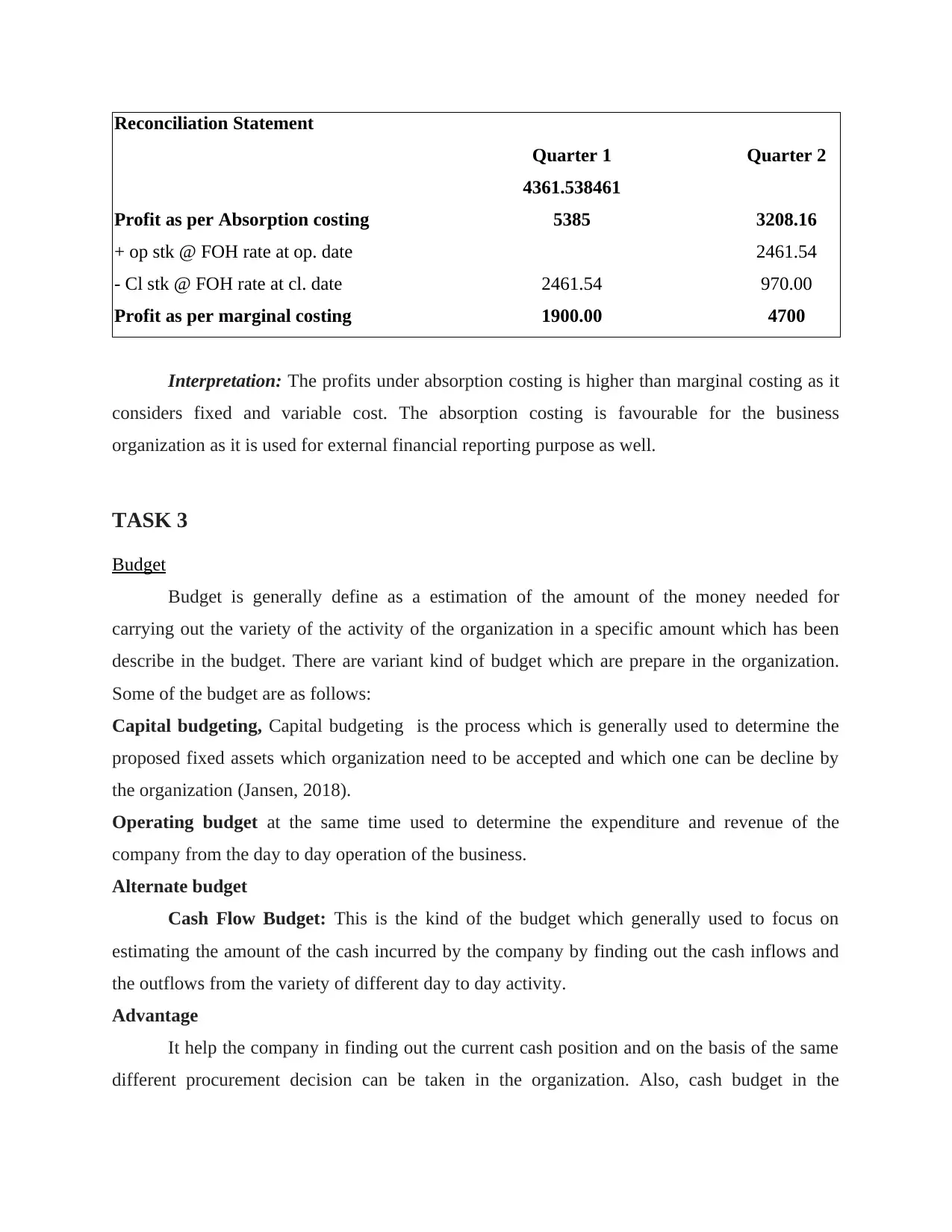
Reconciliation Statement
Quarter 1 Quarter 2
Profit as per Absorption costing
4361.538461
5385 3208.16
+ op stk @ FOH rate at op. date 2461.54
- Cl stk @ FOH rate at cl. date 2461.54 970.00
Profit as per marginal costing 1900.00 4700
Interpretation: The profits under absorption costing is higher than marginal costing as it
considers fixed and variable cost. The absorption costing is favourable for the business
organization as it is used for external financial reporting purpose as well.
TASK 3
Budget
Budget is generally define as a estimation of the amount of the money needed for
carrying out the variety of the activity of the organization in a specific amount which has been
describe in the budget. There are variant kind of budget which are prepare in the organization.
Some of the budget are as follows:
Capital budgeting, Capital budgeting is the process which is generally used to determine the
proposed fixed assets which organization need to be accepted and which one can be decline by
the organization (Jansen, 2018).
Operating budget at the same time used to determine the expenditure and revenue of the
company from the day to day operation of the business.
Alternate budget
Cash Flow Budget: This is the kind of the budget which generally used to focus on
estimating the amount of the cash incurred by the company by finding out the cash inflows and
the outflows from the variety of different day to day activity.
Advantage
It help the company in finding out the current cash position and on the basis of the same
different procurement decision can be taken in the organization. Also, cash budget in the
Quarter 1 Quarter 2
Profit as per Absorption costing
4361.538461
5385 3208.16
+ op stk @ FOH rate at op. date 2461.54
- Cl stk @ FOH rate at cl. date 2461.54 970.00
Profit as per marginal costing 1900.00 4700
Interpretation: The profits under absorption costing is higher than marginal costing as it
considers fixed and variable cost. The absorption costing is favourable for the business
organization as it is used for external financial reporting purpose as well.
TASK 3
Budget
Budget is generally define as a estimation of the amount of the money needed for
carrying out the variety of the activity of the organization in a specific amount which has been
describe in the budget. There are variant kind of budget which are prepare in the organization.
Some of the budget are as follows:
Capital budgeting, Capital budgeting is the process which is generally used to determine the
proposed fixed assets which organization need to be accepted and which one can be decline by
the organization (Jansen, 2018).
Operating budget at the same time used to determine the expenditure and revenue of the
company from the day to day operation of the business.
Alternate budget
Cash Flow Budget: This is the kind of the budget which generally used to focus on
estimating the amount of the cash incurred by the company by finding out the cash inflows and
the outflows from the variety of different day to day activity.
Advantage
It help the company in finding out the current cash position and on the basis of the same
different procurement decision can be taken in the organization. Also, cash budget in the
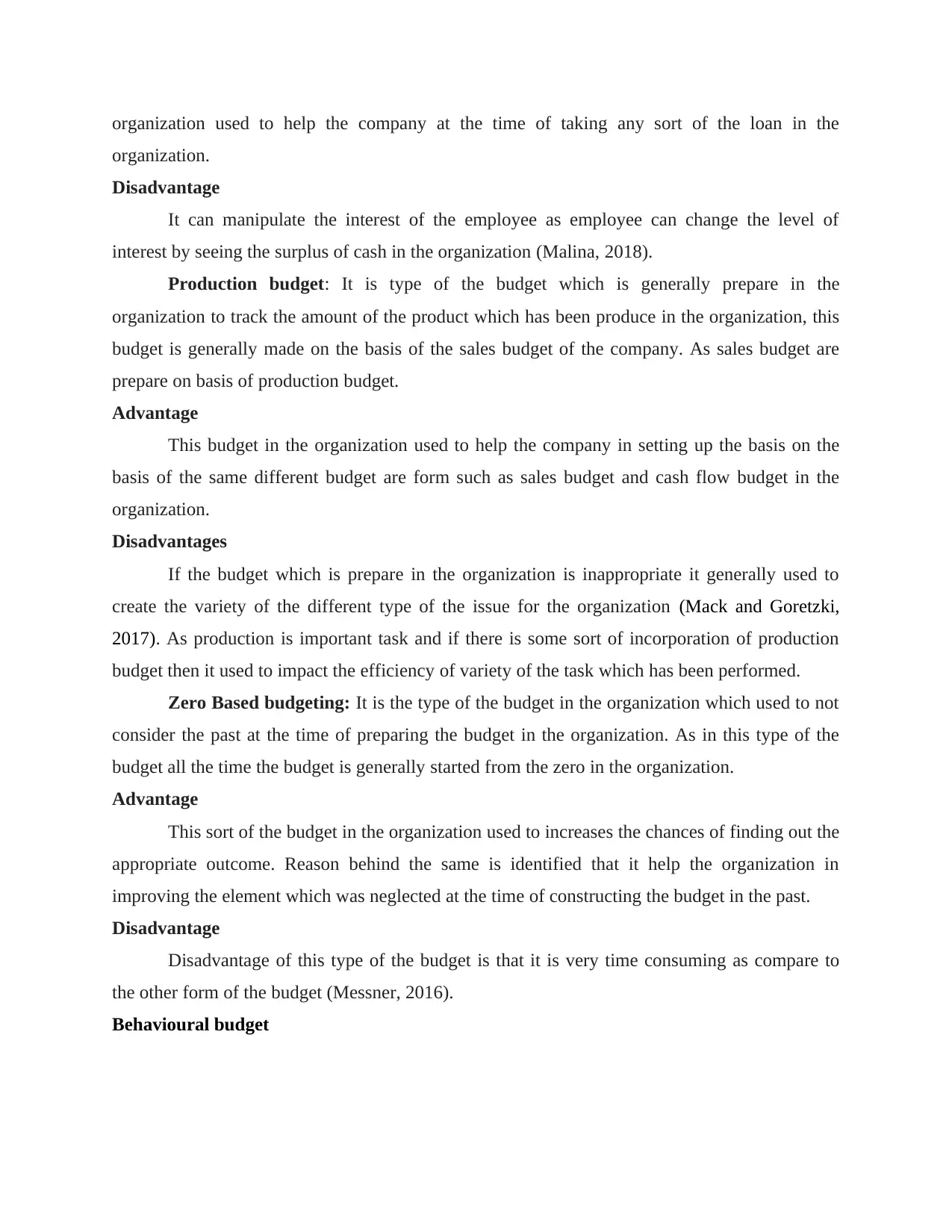
organization used to help the company at the time of taking any sort of the loan in the
organization.
Disadvantage
It can manipulate the interest of the employee as employee can change the level of
interest by seeing the surplus of cash in the organization (Malina, 2018).
Production budget: It is type of the budget which is generally prepare in the
organization to track the amount of the product which has been produce in the organization, this
budget is generally made on the basis of the sales budget of the company. As sales budget are
prepare on basis of production budget.
Advantage
This budget in the organization used to help the company in setting up the basis on the
basis of the same different budget are form such as sales budget and cash flow budget in the
organization.
Disadvantages
If the budget which is prepare in the organization is inappropriate it generally used to
create the variety of the different type of the issue for the organization (Mack and Goretzki,
2017). As production is important task and if there is some sort of incorporation of production
budget then it used to impact the efficiency of variety of the task which has been performed.
Zero Based budgeting: It is the type of the budget in the organization which used to not
consider the past at the time of preparing the budget in the organization. As in this type of the
budget all the time the budget is generally started from the zero in the organization.
Advantage
This sort of the budget in the organization used to increases the chances of finding out the
appropriate outcome. Reason behind the same is identified that it help the organization in
improving the element which was neglected at the time of constructing the budget in the past.
Disadvantage
Disadvantage of this type of the budget is that it is very time consuming as compare to
the other form of the budget (Messner, 2016).
Behavioural budget
organization.
Disadvantage
It can manipulate the interest of the employee as employee can change the level of
interest by seeing the surplus of cash in the organization (Malina, 2018).
Production budget: It is type of the budget which is generally prepare in the
organization to track the amount of the product which has been produce in the organization, this
budget is generally made on the basis of the sales budget of the company. As sales budget are
prepare on basis of production budget.
Advantage
This budget in the organization used to help the company in setting up the basis on the
basis of the same different budget are form such as sales budget and cash flow budget in the
organization.
Disadvantages
If the budget which is prepare in the organization is inappropriate it generally used to
create the variety of the different type of the issue for the organization (Mack and Goretzki,
2017). As production is important task and if there is some sort of incorporation of production
budget then it used to impact the efficiency of variety of the task which has been performed.
Zero Based budgeting: It is the type of the budget in the organization which used to not
consider the past at the time of preparing the budget in the organization. As in this type of the
budget all the time the budget is generally started from the zero in the organization.
Advantage
This sort of the budget in the organization used to increases the chances of finding out the
appropriate outcome. Reason behind the same is identified that it help the organization in
improving the element which was neglected at the time of constructing the budget in the past.
Disadvantage
Disadvantage of this type of the budget is that it is very time consuming as compare to
the other form of the budget (Messner, 2016).
Behavioural budget
Paraphrase This Document
Need a fresh take? Get an instant paraphrase of this document with our AI Paraphraser
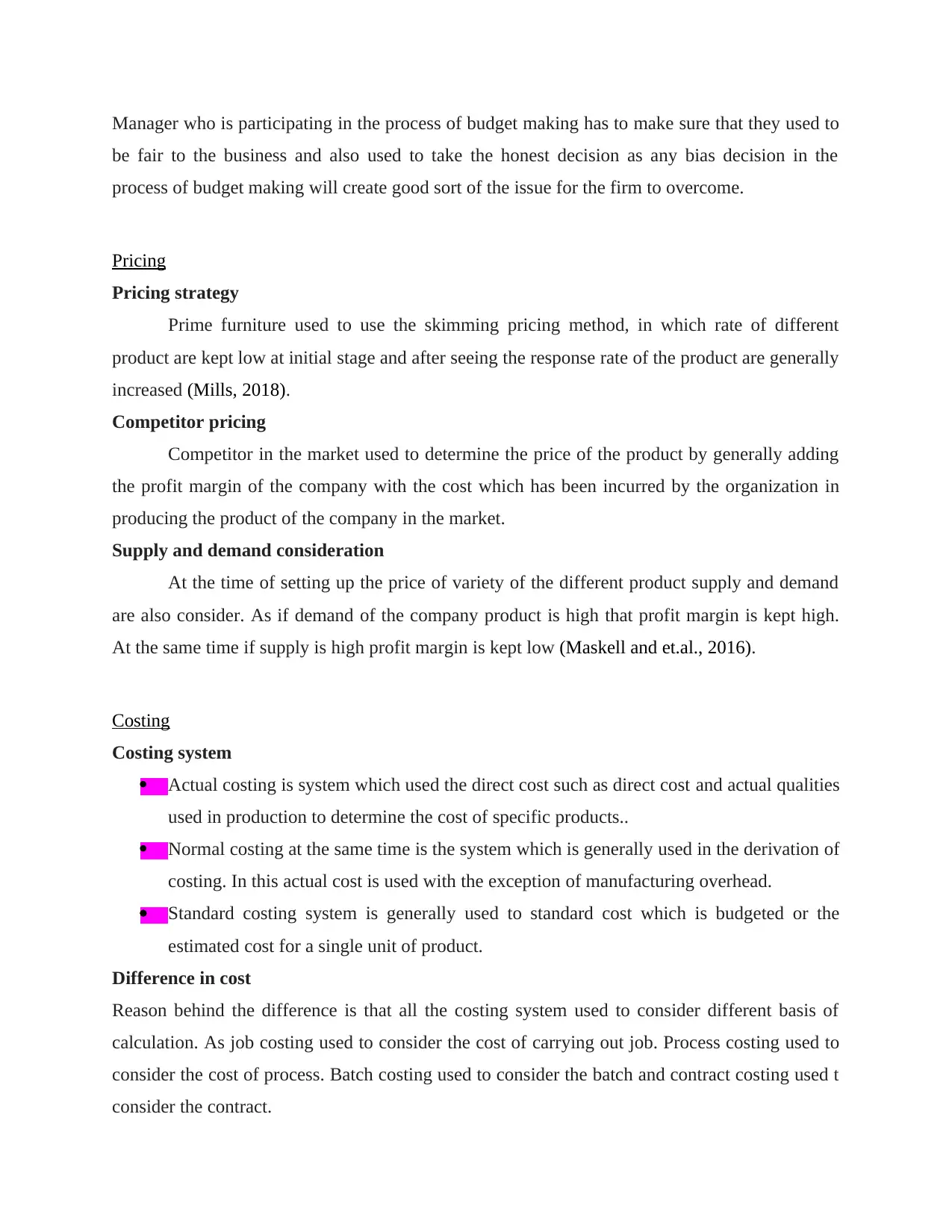
Manager who is participating in the process of budget making has to make sure that they used to
be fair to the business and also used to take the honest decision as any bias decision in the
process of budget making will create good sort of the issue for the firm to overcome.
Pricing
Pricing strategy
Prime furniture used to use the skimming pricing method, in which rate of different
product are kept low at initial stage and after seeing the response rate of the product are generally
increased (Mills, 2018).
Competitor pricing
Competitor in the market used to determine the price of the product by generally adding
the profit margin of the company with the cost which has been incurred by the organization in
producing the product of the company in the market.
Supply and demand consideration
At the time of setting up the price of variety of the different product supply and demand
are also consider. As if demand of the company product is high that profit margin is kept high.
At the same time if supply is high profit margin is kept low (Maskell and et.al., 2016).
Costing
Costing system
Actual costing is system which used the direct cost such as direct cost and actual qualities
used in production to determine the cost of specific products..
Normal costing at the same time is the system which is generally used in the derivation of
costing. In this actual cost is used with the exception of manufacturing overhead.
Standard costing system is generally used to standard cost which is budgeted or the
estimated cost for a single unit of product.
Difference in cost
Reason behind the difference is that all the costing system used to consider different basis of
calculation. As job costing used to consider the cost of carrying out job. Process costing used to
consider the cost of process. Batch costing used to consider the batch and contract costing used t
consider the contract.
be fair to the business and also used to take the honest decision as any bias decision in the
process of budget making will create good sort of the issue for the firm to overcome.
Pricing
Pricing strategy
Prime furniture used to use the skimming pricing method, in which rate of different
product are kept low at initial stage and after seeing the response rate of the product are generally
increased (Mills, 2018).
Competitor pricing
Competitor in the market used to determine the price of the product by generally adding
the profit margin of the company with the cost which has been incurred by the organization in
producing the product of the company in the market.
Supply and demand consideration
At the time of setting up the price of variety of the different product supply and demand
are also consider. As if demand of the company product is high that profit margin is kept high.
At the same time if supply is high profit margin is kept low (Maskell and et.al., 2016).
Costing
Costing system
Actual costing is system which used the direct cost such as direct cost and actual qualities
used in production to determine the cost of specific products..
Normal costing at the same time is the system which is generally used in the derivation of
costing. In this actual cost is used with the exception of manufacturing overhead.
Standard costing system is generally used to standard cost which is budgeted or the
estimated cost for a single unit of product.
Difference in cost
Reason behind the difference is that all the costing system used to consider different basis of
calculation. As job costing used to consider the cost of carrying out job. Process costing used to
consider the cost of process. Batch costing used to consider the batch and contract costing used t
consider the contract.

Strategic Position
SWOT
Strength Weakness
Financial Strength
Goodwill
Profit margin
employee conflict
Threat Opportunity
Competition
Legal law
Technology adoption
expansion
PEST
Political factor: Not that favourable as Brexit has created good sort of barrier in between
different country.
Environmental Factor: It is favourable in the nation as inflation and interest rate are at
positive side which help in getting different finance at nominal rate.
Social Factor: It is very favourable as organization is able to cope up with change in
preference
Technological: Good opportunity to adopt new technology in the market.
Porters 5
Threat from competitor is high
Threat from new entrant is low
Threat from substitute product is low
Bargaining power of supplier is low
Bargaining power of consumer is high
SWOT
Strength Weakness
Financial Strength
Goodwill
Profit margin
employee conflict
Threat Opportunity
Competition
Legal law
Technology adoption
expansion
PEST
Political factor: Not that favourable as Brexit has created good sort of barrier in between
different country.
Environmental Factor: It is favourable in the nation as inflation and interest rate are at
positive side which help in getting different finance at nominal rate.
Social Factor: It is very favourable as organization is able to cope up with change in
preference
Technological: Good opportunity to adopt new technology in the market.
Porters 5
Threat from competitor is high
Threat from new entrant is low
Threat from substitute product is low
Bargaining power of supplier is low
Bargaining power of consumer is high
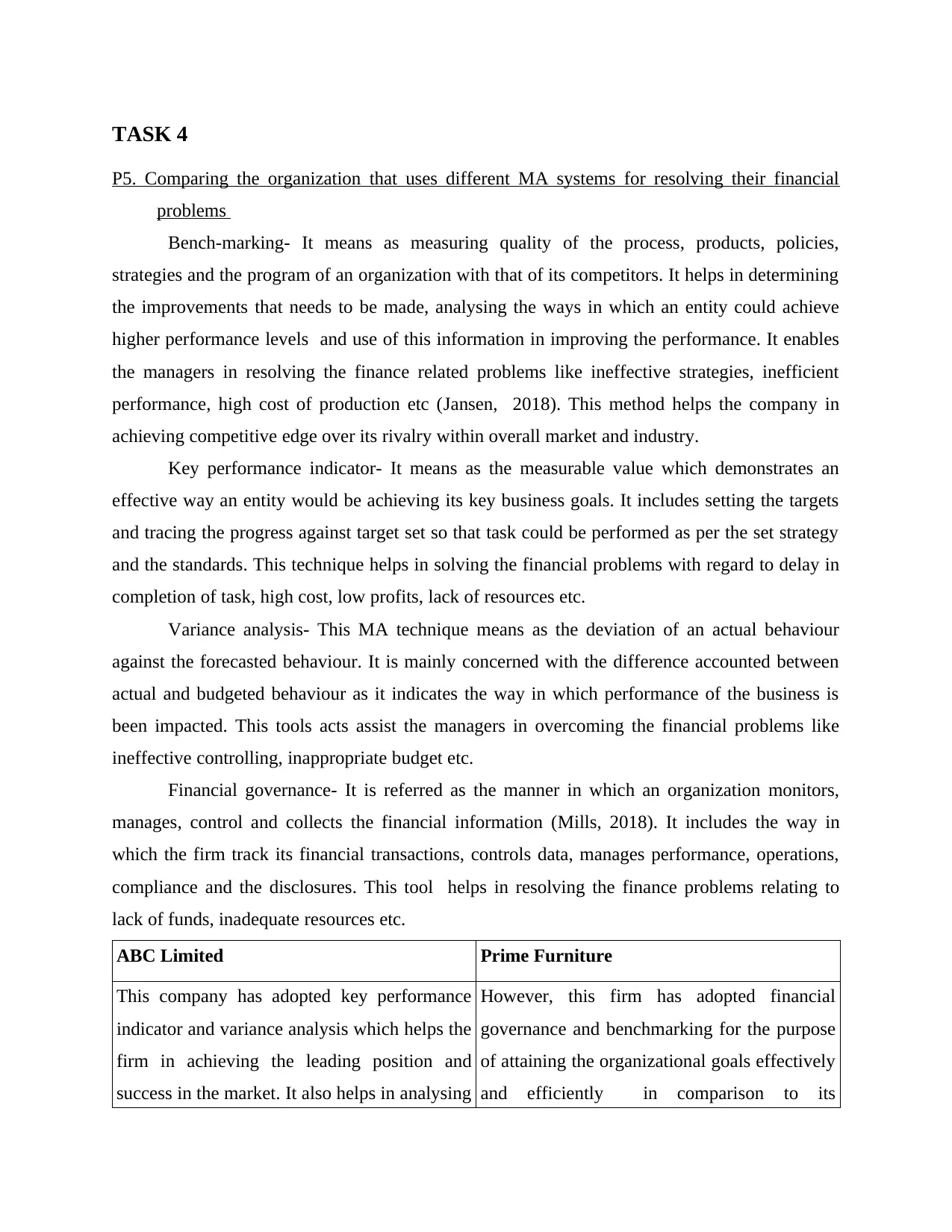
TASK 4
P5. Comparing the organization that uses different MA systems for resolving their financial
problems
Bench-marking- It means as measuring quality of the process, products, policies,
strategies and the program of an organization with that of its competitors. It helps in determining
the improvements that needs to be made, analysing the ways in which an entity could achieve
higher performance levels and use of this information in improving the performance. It enables
the managers in resolving the finance related problems like ineffective strategies, inefficient
performance, high cost of production etc (Jansen, 2018). This method helps the company in
achieving competitive edge over its rivalry within overall market and industry.
Key performance indicator- It means as the measurable value which demonstrates an
effective way an entity would be achieving its key business goals. It includes setting the targets
and tracing the progress against target set so that task could be performed as per the set strategy
and the standards. This technique helps in solving the financial problems with regard to delay in
completion of task, high cost, low profits, lack of resources etc.
Variance analysis- This MA technique means as the deviation of an actual behaviour
against the forecasted behaviour. It is mainly concerned with the difference accounted between
actual and budgeted behaviour as it indicates the way in which performance of the business is
been impacted. This tools acts assist the managers in overcoming the financial problems like
ineffective controlling, inappropriate budget etc.
Financial governance- It is referred as the manner in which an organization monitors,
manages, control and collects the financial information (Mills, 2018). It includes the way in
which the firm track its financial transactions, controls data, manages performance, operations,
compliance and the disclosures. This tool helps in resolving the finance problems relating to
lack of funds, inadequate resources etc.
ABC Limited Prime Furniture
This company has adopted key performance
indicator and variance analysis which helps the
firm in achieving the leading position and
success in the market. It also helps in analysing
However, this firm has adopted financial
governance and benchmarking for the purpose
of attaining the organizational goals effectively
and efficiently in comparison to its
P5. Comparing the organization that uses different MA systems for resolving their financial
problems
Bench-marking- It means as measuring quality of the process, products, policies,
strategies and the program of an organization with that of its competitors. It helps in determining
the improvements that needs to be made, analysing the ways in which an entity could achieve
higher performance levels and use of this information in improving the performance. It enables
the managers in resolving the finance related problems like ineffective strategies, inefficient
performance, high cost of production etc (Jansen, 2018). This method helps the company in
achieving competitive edge over its rivalry within overall market and industry.
Key performance indicator- It means as the measurable value which demonstrates an
effective way an entity would be achieving its key business goals. It includes setting the targets
and tracing the progress against target set so that task could be performed as per the set strategy
and the standards. This technique helps in solving the financial problems with regard to delay in
completion of task, high cost, low profits, lack of resources etc.
Variance analysis- This MA technique means as the deviation of an actual behaviour
against the forecasted behaviour. It is mainly concerned with the difference accounted between
actual and budgeted behaviour as it indicates the way in which performance of the business is
been impacted. This tools acts assist the managers in overcoming the financial problems like
ineffective controlling, inappropriate budget etc.
Financial governance- It is referred as the manner in which an organization monitors,
manages, control and collects the financial information (Mills, 2018). It includes the way in
which the firm track its financial transactions, controls data, manages performance, operations,
compliance and the disclosures. This tool helps in resolving the finance problems relating to
lack of funds, inadequate resources etc.
ABC Limited Prime Furniture
This company has adopted key performance
indicator and variance analysis which helps the
firm in achieving the leading position and
success in the market. It also helps in analysing
However, this firm has adopted financial
governance and benchmarking for the purpose
of attaining the organizational goals effectively
and efficiently in comparison to its
Secure Best Marks with AI Grader
Need help grading? Try our AI Grader for instant feedback on your assignments.
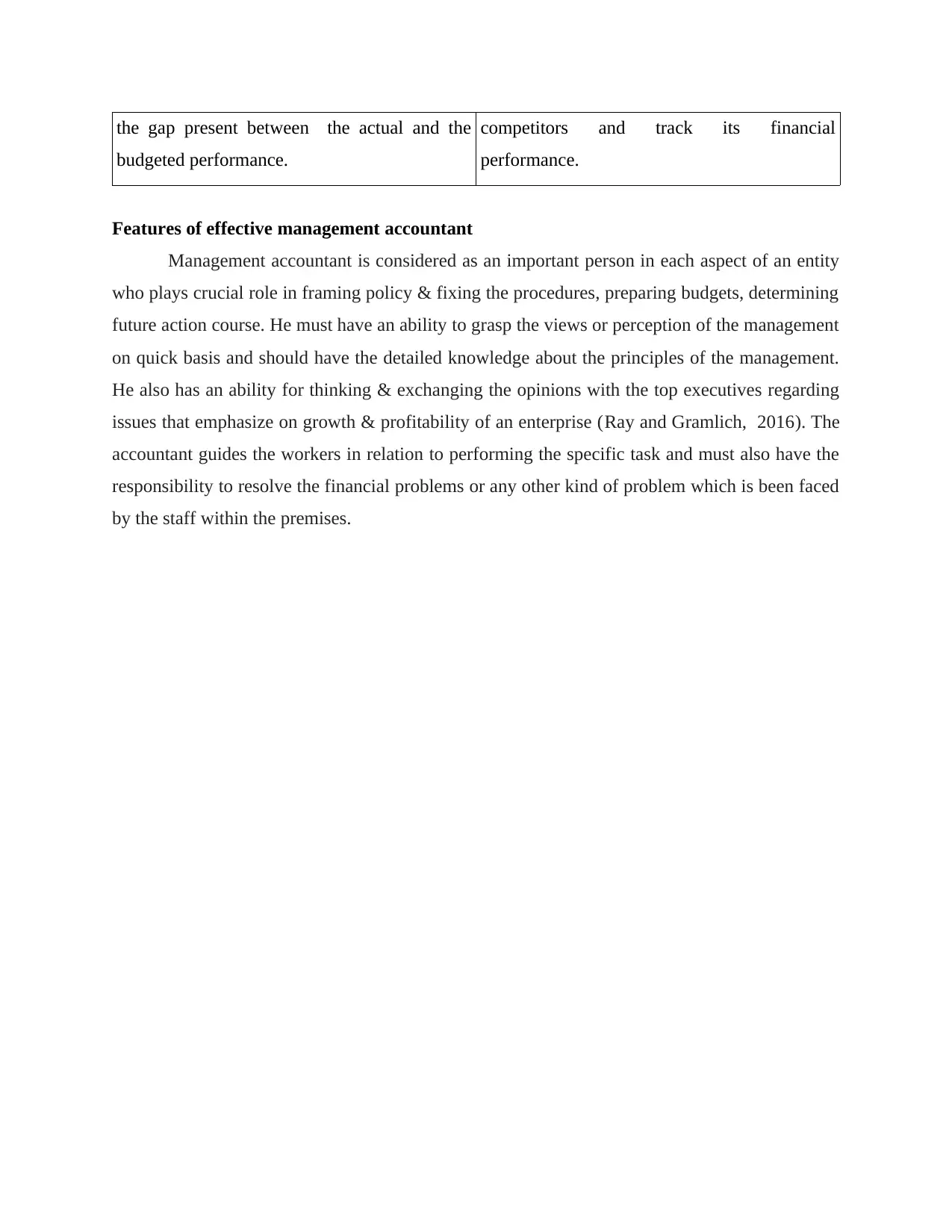
the gap present between the actual and the
budgeted performance.
competitors and track its financial
performance.
Features of effective management accountant
Management accountant is considered as an important person in each aspect of an entity
who plays crucial role in framing policy & fixing the procedures, preparing budgets, determining
future action course. He must have an ability to grasp the views or perception of the management
on quick basis and should have the detailed knowledge about the principles of the management.
He also has an ability for thinking & exchanging the opinions with the top executives regarding
issues that emphasize on growth & profitability of an enterprise (Ray and Gramlich, 2016). The
accountant guides the workers in relation to performing the specific task and must also have the
responsibility to resolve the financial problems or any other kind of problem which is been faced
by the staff within the premises.
budgeted performance.
competitors and track its financial
performance.
Features of effective management accountant
Management accountant is considered as an important person in each aspect of an entity
who plays crucial role in framing policy & fixing the procedures, preparing budgets, determining
future action course. He must have an ability to grasp the views or perception of the management
on quick basis and should have the detailed knowledge about the principles of the management.
He also has an ability for thinking & exchanging the opinions with the top executives regarding
issues that emphasize on growth & profitability of an enterprise (Ray and Gramlich, 2016). The
accountant guides the workers in relation to performing the specific task and must also have the
responsibility to resolve the financial problems or any other kind of problem which is been faced
by the staff within the premises.
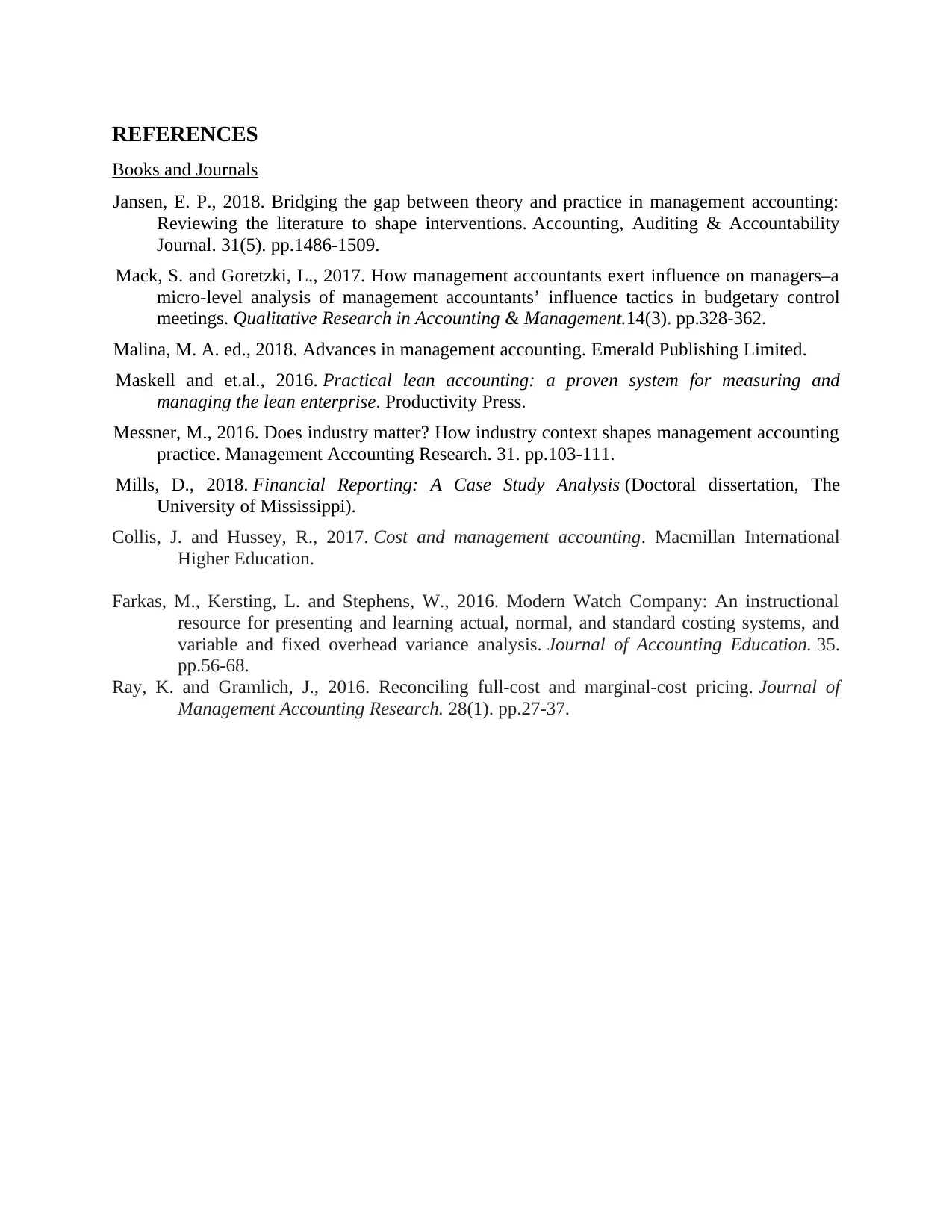
REFERENCES
Books and Journals
Jansen, E. P., 2018. Bridging the gap between theory and practice in management accounting:
Reviewing the literature to shape interventions. Accounting, Auditing & Accountability
Journal. 31(5). pp.1486-1509.
Mack, S. and Goretzki, L., 2017. How management accountants exert influence on managers–a
micro-level analysis of management accountants’ influence tactics in budgetary control
meetings. Qualitative Research in Accounting & Management.14(3). pp.328-362.
Malina, M. A. ed., 2018. Advances in management accounting. Emerald Publishing Limited.
Maskell and et.al., 2016. Practical lean accounting: a proven system for measuring and
managing the lean enterprise. Productivity Press.
Messner, M., 2016. Does industry matter? How industry context shapes management accounting
practice. Management Accounting Research. 31. pp.103-111.
Mills, D., 2018. Financial Reporting: A Case Study Analysis (Doctoral dissertation, The
University of Mississippi).
Collis, J. and Hussey, R., 2017. Cost and management accounting. Macmillan International
Higher Education.
Farkas, M., Kersting, L. and Stephens, W., 2016. Modern Watch Company: An instructional
resource for presenting and learning actual, normal, and standard costing systems, and
variable and fixed overhead variance analysis. Journal of Accounting Education. 35.
pp.56-68.
Ray, K. and Gramlich, J., 2016. Reconciling full-cost and marginal-cost pricing. Journal of
Management Accounting Research. 28(1). pp.27-37.
Books and Journals
Jansen, E. P., 2018. Bridging the gap between theory and practice in management accounting:
Reviewing the literature to shape interventions. Accounting, Auditing & Accountability
Journal. 31(5). pp.1486-1509.
Mack, S. and Goretzki, L., 2017. How management accountants exert influence on managers–a
micro-level analysis of management accountants’ influence tactics in budgetary control
meetings. Qualitative Research in Accounting & Management.14(3). pp.328-362.
Malina, M. A. ed., 2018. Advances in management accounting. Emerald Publishing Limited.
Maskell and et.al., 2016. Practical lean accounting: a proven system for measuring and
managing the lean enterprise. Productivity Press.
Messner, M., 2016. Does industry matter? How industry context shapes management accounting
practice. Management Accounting Research. 31. pp.103-111.
Mills, D., 2018. Financial Reporting: A Case Study Analysis (Doctoral dissertation, The
University of Mississippi).
Collis, J. and Hussey, R., 2017. Cost and management accounting. Macmillan International
Higher Education.
Farkas, M., Kersting, L. and Stephens, W., 2016. Modern Watch Company: An instructional
resource for presenting and learning actual, normal, and standard costing systems, and
variable and fixed overhead variance analysis. Journal of Accounting Education. 35.
pp.56-68.
Ray, K. and Gramlich, J., 2016. Reconciling full-cost and marginal-cost pricing. Journal of
Management Accounting Research. 28(1). pp.27-37.
1 out of 12
Related Documents
Your All-in-One AI-Powered Toolkit for Academic Success.
+13062052269
info@desklib.com
Available 24*7 on WhatsApp / Email
![[object Object]](/_next/static/media/star-bottom.7253800d.svg)
Unlock your academic potential
© 2024 | Zucol Services PVT LTD | All rights reserved.




